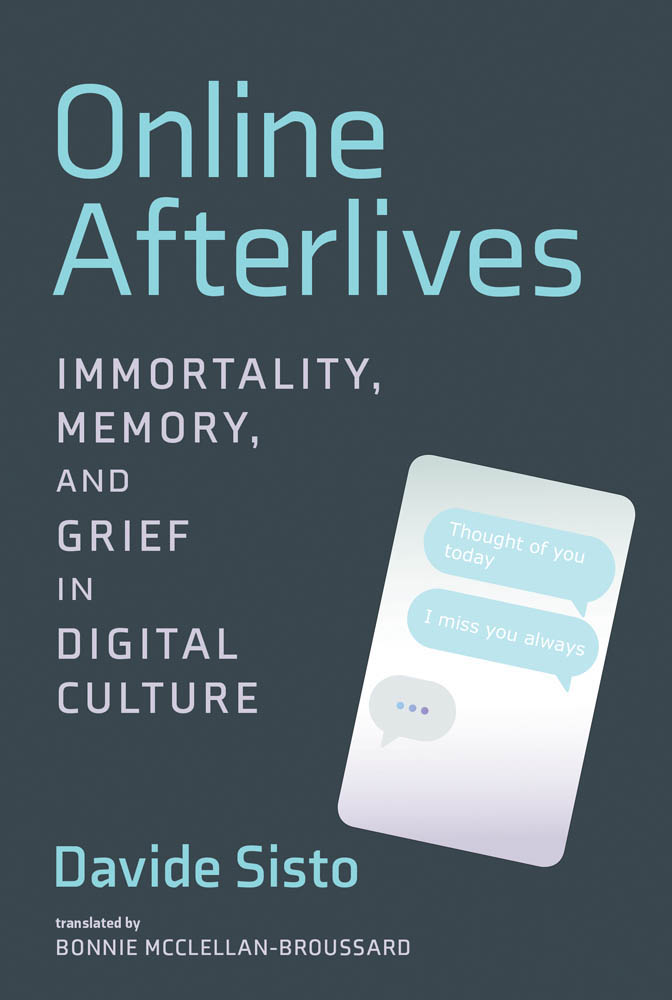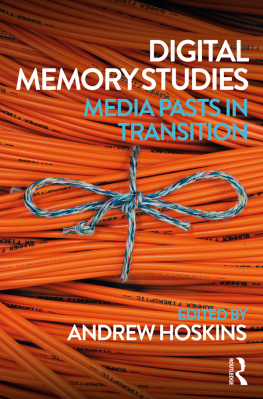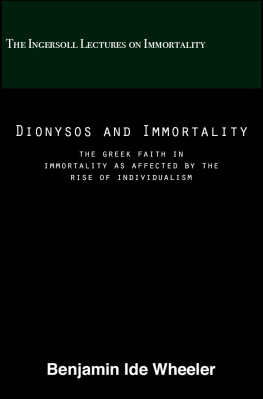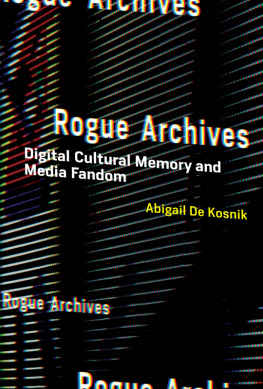Davide Sisto - Immortality, Memory, and Grief in Digital Culture
Here you can read online Davide Sisto - Immortality, Memory, and Grief in Digital Culture full text of the book (entire story) in english for free. Download pdf and epub, get meaning, cover and reviews about this ebook. year: 2020, publisher: MIT Press, genre: Home and family. Description of the work, (preface) as well as reviews are available. Best literature library LitArk.com created for fans of good reading and offers a wide selection of genres:
Romance novel
Science fiction
Adventure
Detective
Science
History
Home and family
Prose
Art
Politics
Computer
Non-fiction
Religion
Business
Children
Humor
Choose a favorite category and find really read worthwhile books. Enjoy immersion in the world of imagination, feel the emotions of the characters or learn something new for yourself, make an fascinating discovery.

- Book:Immortality, Memory, and Grief in Digital Culture
- Author:
- Publisher:MIT Press
- Genre:
- Year:2020
- Rating:5 / 5
- Favourites:Add to favourites
- Your mark:
- 100
- 1
- 2
- 3
- 4
- 5
Immortality, Memory, and Grief in Digital Culture: summary, description and annotation
We offer to read an annotation, description, summary or preface (depends on what the author of the book "Immortality, Memory, and Grief in Digital Culture" wrote himself). If you haven't found the necessary information about the book — write in the comments, we will try to find it.
Immortality, Memory, and Grief in Digital Culture — read online for free the complete book (whole text) full work
Below is the text of the book, divided by pages. System saving the place of the last page read, allows you to conveniently read the book "Immortality, Memory, and Grief in Digital Culture" online for free, without having to search again every time where you left off. Put a bookmark, and you can go to the page where you finished reading at any time.
Font size:
Interval:
Bookmark:

Online Afterlives
Immortality, Memory, and Grief in Digital Culture
Davide Sisto
Translated by Bonnie McClellan-Broussard
The MIT Press
Cambridge, Massachusetts | London, England
2020 Massachusetts Institute of Technology
Original Italian edition: 2018 Bollati Boringhieri editore, Torino
All rights reserved. No part of this book may be reproduced in any form by any electronic or mechanical means (including photocopying, recording, or information storage and retrieval) without permission in writing from the publisher.
Library of Congress Cataloging-in-Publication Data
Names: Sisto, Davide, 1978- author. | McClellan-Broussard, Bonnie, translator.
Title: Online afterlives : immortality, memory, and grief in digital culture / Davide Sisto ; translated by Bonnie McClellan-Broussard.
Other titles: Morte si fa social. English
Description: Cambridge, Massachusetts : The MIT Press, [2020] | Original Italian edition: 2018 Bollati Boringhiere editore, Torino--Title page verso. | Includes bibliographical references and index.
Identifiers: LCCN 2019058436 | ISBN 9780262539395 (paperback)
Subjects: LCSH: Death--Social aspects. | Online social networks--Social aspects. | Internet--Social aspects.
Classification: LCC HQ1073 .S5413 2020 | DDC 306.9--dc23
LC record available at https://lccn.loc.gov/2019058436
d_r0
Death Returns to the Web
When I turned on my smartphone on the morning of November 14, 2014, I got a notification from Facebook. It was reminding me to send a birthday message to my friend Alessandro. Contribuisci a rendere unica la sua giornata (Help to make his day special) appeared beside his profile picture. All of this was unremarkable, except for the fact that Alessandro was dead. He had died the previous summer. For a few seconds I was bewildered, unable to fully comprehend the disconnect. My first instinct was to go to his Facebook profile page. I started looking through his daily posts, reading some of his past status updates, looking at the photographs he had posted. Then I went straight to our private conversations on Facebook Messenger and WhatsApp. Alessandro was an emerging film director who had enjoyed some international success with a documentary about the experiences of albinos in Tanzania. His lively Facebook page bore witness to the many trips hed made to different places around the world over the years. And then, suddenly, silence. A void that brought together Alessandros last living update with the first posthumous memorial post written by a grieving friend.
All of this was both disconcerting and emotionally powerful for me. It forced me to reflect on how death, so often kept at arms length from our everyday lives, is foisted peremptorily upon us on social networks, chat threads, and the internet in general.
The presence of a deceased persons Facebook profile in the midst of the profiles of the living is a phenomenon that can in no way be compared to, for example, a visit to a grave (or other such memorial place). Nor is it comparable to pulling out a photograph that youve kept in an album tucked away on a shelf. We have come to expect the traces of a dead persons life to settle into fixed spaces and objects, or memories of their family members and friends. And we assume their legacyfor example, the lessons they passed on or the example they set as parentswill, one way or the other, come to shape the lives of those they were close to. So consider now how a persons digital footprint is fated to wander aimlessly, perhaps eternally, indiscriminately confronting anyone with whom they may have had even the briefest interaction or slightest acquaintance. These days, we can encounter traces of the dead when we type their names into a search engine or, as in my case, when we receive a notification about a friends birthday. In computing terms, every random spider or web crawler that systematically browses the web, in order to create an index, sucks up this dead data, locking it away in a kind of digital mausoleum that is always accessible to living users.
The South Korean philosopher Byung-Chul Han, one of the foremost critics of digital culture, argues that while the internet resembles Jeremy Benthams panopticon in many ways, unlike Benthams panopticonwhich was devoid of an effective registration systemthe internet makes it possible to systematically record our entire lives and make them accessible through its multiform digital networks. In other words, we are all fated to become digital ghosts, trapped in posterity, without our consent, forever digitally undead. These enduring online records are paradoxically a reminder of both the inevitability of death and the impossibility of the traces of our lives ever being truly erased.
One of the purposes of death studies is to help people accept death as an integral part of life and provide support to those who need to find a way to mourn. I wonder then if digital culture doesnt unintentionally offer an opportunity to those of us who, over the last few decades, have been trying to offset the sociocultural denial of death in the West? In the West, we continue to resist the reality of mortality and we keep the dead, literally and figuratively, at a distance. After all, to talk about death, lets say during a lunch with friends or on a TV chat show, is often still considered taboo, macabre, or in bad taste.
We struggle even in our attempts to discuss death purely in terms of it being a biomedical phenomenon, as the American surgeon Atul Gawande makes clear in his bestseller Being Mortal: Medicine and What Matters in the End. We need only consider the results of a recent piece of scientific research carried out in Australia on a sample of more than three thousand people from thirty-nine different countries that analyzed the linguistic expressions commonly used to describe a persons death. They clearly show how deeply rooted is the tendency to name anything but death itself. In addition to the idiomatic and ubiquitous passed away, passed on, and departed, an impressive variety of euphemisms, metaphors, and paraphrases exists to allow us to avoid uttering the word dead in the process of relaying the news of the death of a loved one.
Several English-language idioms stand out for their black humor: wrong side of the grass and taking a dirt nap are just two examples. Many paraphrases have specific cultural and historical origins: for example, shuffled off this mortal coil is a well-known quote taken from Shakespeares Hamlet. Six feet under is a phrase that dates back to 1665 and indicates the need to bury plague victims as deeply as possible. Recently, this phrase has been used as both the name of a death metal band and the title of a very successful American TV series about, unsurprisingly, thanatological topics. Promoted to glory is a metaphor used by the Salvation Army when referring to victims of a war. Theres also no shortage of references in local slang, like carked it: in Australia cark is the call of the crow, an animal whose association with death and cemeteries hardly needs to be pointed out. Then theres brown bread, used in Cockney rhyming slang, the patois of the Greater London area, simply because it rhymes with dead.
Linguistic formulas also clearly evoke the illusion of a life without death. One commonly heard in Italy is
Font size:
Interval:
Bookmark:
Similar books «Immortality, Memory, and Grief in Digital Culture»
Look at similar books to Immortality, Memory, and Grief in Digital Culture. We have selected literature similar in name and meaning in the hope of providing readers with more options to find new, interesting, not yet read works.
Discussion, reviews of the book Immortality, Memory, and Grief in Digital Culture and just readers' own opinions. Leave your comments, write what you think about the work, its meaning or the main characters. Specify what exactly you liked and what you didn't like, and why you think so.








